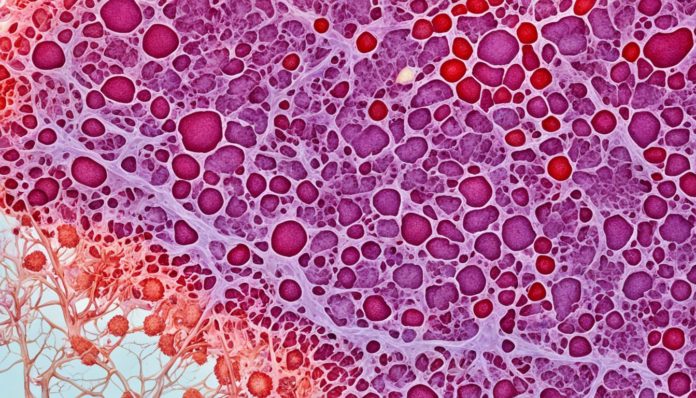Did you know nearly 75% of women will face a vaginal yeast infection in their lives? This fact highlights the widespread nature of candidiasis, a fungal infection from too much Candida albicans. Factors like the immune system and lifestyle can spark this uncomfortable condition, making knowledge of its causes and treatments essential.
Candidiasis may seem like a small issue, yet it can become serious if ignored. This detailed guide covers the root causes and effective treatments for managing candidiasis. It offers handy tips for anyone looking to prevent or handle current infections, enriching your understanding of this common fungal challenge.
Key Takeaways
- Candidiasis affects a significant portion of the population, with 75% of women experiencing at least one vaginal yeast infection in their lifetime.
- Candidiasis is caused by the overgrowth of Candida albicans, a common fungus.
- Understanding the causes and treatments of candidiasis is essential for effective management and prevention.
- Immune system factors, lifestyle choices, and environmental influences all play a role in the development of candidiasis.
- A range of candida treatment options, from medical interventions to natural remedies, are available.
What is Candidiasis?
Candidiasis is an infection from too much Candida fungus, mainly Candida albicans. It can show up in many body parts. There are various forms like thrush and vaginal yeast infections. Knowing about this condition helps identify its signs and how serious it is.

Overview of Candidiasis
When the natural balance of Candida fungus is off, candidiasis happens. It leads to symptoms all over. Things like a weak immune system, antibiotics, and hormonal changes can cause it. This lets the fungus grow fast, leading to infection and health problems. Oral thrush and vaginal yeast infections are common forms.
Types of Candidiasis
Candidiasis types depend on where the infection is and how bad it is:
- Oral Thrush: This affects the mouth, causing white patches in the mouth and throat.
- Vaginal Yeast Infection: It causes itching, discharge, and discomfort in the vaginal area.
- Systemic Candidiasis: A serious condition where the infection spreads, possibly hitting organs and bloodstream.
Different Candida problems mean people need the right treatment. Understanding these types helps in finding how to handle it.
Common Causes of Candidiasis
Candidiasis, often called a yeast infection, comes from different factors that allow Candida to grow too much. It’s important to know these causes to prevent and manage the condition better.

Immune System Factors
A weak immune system is a big cause of candidiasis. People with lower immunity, from chronic illnesses or treatments that lower the immune response, are at greater risk. If our natural defenses are low, Candida can flourish and cause infections.
Impact of Antibiotics
Taking antibiotics can also lead to candidiasis. Antibiotics fight bacterial infections but can also throw off our body’s normal balance. This makes it easier for Candida to grow and can raise the chance of getting an infection.
Hormonal Changes
Hormone changes, especially estrogen, affect candidiasis risks. Women often face yeast infections during times like pregnancy, periods, or when using birth control. These changes can make the vaginal area more welcoming to Candida.
Diet and Lifestyle Influences
Certain diet and lifestyle habits can also cause Candida to overgrow. Eating too much sugar and refined carbs helps Candida grow. Also, too much stress and not enough sleep can weaken our immune system. This makes it easier for Candida to take hold.
By understanding these common causes, people can make changes to prevent and manage candidiasis. This can lead to improved health and wellness.
Recognizing Candida Symptoms
It’s vital to spot candida symptoms early for the best treatment results. The symptoms can change based on where they appear on the body. We will go over common signs of oral candidiasis, vaginal yeast infections, and skin infections. This helps you stay aware and take action quickly.
Signs of Thrush
Oral candidiasis, or thrush, often causes white spots on your tongue and cheeks. You might also experience:
- Redness and soreness in the mouth
- Difficulty swallowing
- Cracking at the corners of the mouth
Symptoms of Vaginal Yeast Infection
Vaginal yeast infections are pretty common. Look out for these symptoms:
- Intense itching and irritation in the vaginal area
- Thick, white, odorless discharge
- Redness and swelling around the vulva
- Pain during intercourse or urination
Other Common Candida Symptoms
As a skin infection, Candida can cause certain signs. Watch for:
- Red and itchy rashes
- Blisters and skin erosion
- Swelling and discomfort
Impact of Candida Overgrowth on Health
Candida overgrowth can cause many health problems. It affects both your immediate and future well-being. Knowing the impacts is key to seeking prompt, effective treatment.
Short-term Health Effects
Short-term effects of *candida* often show up as local infections. They bring discomfort and annoyance. Symptoms like oral thrush, skin rashes, and vaginal yeast infections are common.
These issues can disrupt your day-to-day life. Getting help early can quickly ease these symptoms. This prevents them from turning into bigger health problems.
Long-term Health Consequences
If you ignore it, *systemic candidiasis* might develop, which is dangerous. This condition happens when Candida spreads in the body. It can harm different organs.
This leads to ongoing tiredness, stomach problems, and risky infections for those with weak immunity. Therefore, dealing with candida early is crucial to avoid these severe outcomes.
Diagnosing Candidiasis
Getting the right diagnosis for candidiasis is crucial for effective treatment. Doctors use medical exams and lab tests to spot Candida growth. This helps them figure out the right way to treat it.
Medical Examinations
Doctors start with a detailed medical checkup. They review the patient’s health history and current symptoms. They pay extra attention to areas commonly affected by Candida, like the mouth, skin, and genital regions. This initial step is to see if candidiasis is likely and if more tests are needed.
Lab Tests and Procedures
Lab tests are key in confirming a candidiasis diagnosis. Here are common tests:
- Microscopic Examination: They take samples from the affected area to look for Candida cells under a microscope.
- Culture Tests: These samples are grown in a lab to detect and identify the Candida strain.
- Blood Tests: Blood tests help find Candida in the bloodstream for systemic cases.
These tests give solid proof of Candida overgrowth, making diagnosis accurate. Fast and correct testing is important. It helps doctors make a good treatment plan, helping in beating candidiasis.
Treating Candidiasis Effectively
Managing Candidiasis needs multiple strategies. A key way is using antifungal therapy. This includes oral pills, creams, and IV treatments for tough cases.
For mild infections, over-the-counter creams are a good start. They stop candida growth, easing symptoms. If the infection doesn’t go away, doctors might suggest drugs like fluconazole or itraconazole.
Along with medicine, changing your lifestyle helps keep the infection away. Eating less sugar and processed foods strengthens your body’s defense against candida. Also, staying clean and not overusing antibiotics is crucial for a successful treatment plan.
To summarize the various options:
| Treatment Type | Examples | Usage |
|---|---|---|
| Over-the-Counter | Antifungal creams, ointments | Mild infections |
| Prescription Medications | Fluconazole, Itraconazole | Severe or persistent infections |
| Lifestyle Modifications | Balanced diet, hygiene | Preventing recurrence |
These strategies together help manage Candidiasis. They lessen its effects on your life. Remember, treating with antifungals is crucial, but so is a holistic approach for lasting results.
Natural Remedies for Yeast Infections
Looking into natural ways to fight yeast infections is a whole-body approach. It helps keep your gut healthy. You can do this by changing what you eat, adding in probiotics and special supplements, and using herbs. These steps help your body deal with candida naturally.
Dietary Adjustments
To keep your gut healthy, eat foods that help fight too much yeast. Choose a diet low in sugars and refined carbs. These foods make candida worse. Instead, fill your plate with:
- Leafy greens and non-starchy vegetables
- Lean proteins like chicken, turkey, and fish
- Fermented foods such as yogurt, kefir, and sauerkraut
- Healthy fats from avocados, nuts, and seeds
Probiotics and Supplements
Probiotics are key for a healthy gut. They help keep the good bacteria levels in check. This is critical for fighting candida naturally. High-quality probiotics are a great way to get this good bacteria back. This is especially important if your diet or antibiotics have reduced these beneficial bacteria. People often choose:
- Lactobacillus acidophilus
- Bifidobacterium bifidum
- Saccharomyces boulardii
Certain supplements can also help fight yeast infections. Caprylic acid, grapefruit seed extract, and oregano oil are good choices.
Herbal Remedies
Herbs can also help fight yeast infections. They work well with diet changes and probiotics. Some effective herbs for candida include:
- Garlic, with its antifungal qualities
- Pau d’Arco, used traditionally against fungus
- Aloe vera, which soothes and heals the gut
Using these natural remedies can help keep your gut healthy. This supports your overall well-being. It also lowers your chances of too much candida growth.
Medical Treatments for Candida Albicans
Managing Candida albicans often needs medical help, especially if it’s severe or ongoing. We’ll look at antifungal treatments available, like prescription medications and systemic therapies.
Antifungal Medications
Antifungal meds are key to fight Candida infections. They stop the fungus from growing and spreading. You can find them as creams, ointments, pills, and shots.
Topical antifungals like clotrimazole, miconazole, and nystatin work well for less severe infections.
Prescription Treatments
For tougher or systemic infections, you usually need a prescription antifungal. Doctors might give you pills like fluconazole or itraconazole. These are great for fighting infections throughout the body.
If Candida spreads a lot or doesn’t respond to usual treatments, doctors might use intravenous antifungals. Amphotericin B is one option for these serious cases.
| Medication Type | Examples | Usage |
|---|---|---|
| Topical Antifungals | Clotrimazole, Miconazole, Nystatin | Applied to the affected area for localized infections |
| Oral Antifungals | Fluconazole, Itraconazole | Used for systemic treatment of severe infections |
| Intravenous Antifungals | Amphotericin B | Administered in hospital settings for critical cases |
It’s crucial to stick to the treatment plan to heal properly. Talk with your doctor about the treatment length and dosage for you.
Preventing Candidiasis
Preventing candidiasis is crucial. This section highlights the importance of daily hygiene, a balanced diet, and wise use of antibiotics. These steps help in avoiding candida.
Daily Hygiene Practices
Good personal care habits play a key role. It’s important to brush and floss regularly and get dental check-ups. Wear breathable cotton underwear to lower the risk of vaginal candidiasis.
For those in hospitals, keeping infections at bay is vital. Practices like hand washing are necessary to stop the spread of invasive candidiasis. More tips are available here.
Maintaining a Balanced Diet
Eating right is essential to control candida. Including probiotics and cutting down on sugar benefits gut health. Add olive oil, garlic, and cruciferous veggies for their antifungal effects.
Drinking lots of water and avoiding processed food also helps in staying healthy. This can aid in preventing candida.
Avoiding Antibiotic Overuse
It’s important to use antibiotics only when necessary. Misusing them can upset the balance of bacteria, causing candida to grow. Always complete your course and talk to your doctor if in doubt.
When to Seek Professional Help
Many candidiasis cases can be managed at home with common treatments. But there are times when you must seek medical advice. If your symptoms keep getting worse or don’t go away after trying to treat them, it’s time to see a doctor.
If you’re dealing with constant itching, a lot of discomforts, or the infection keeps coming back, you should visit a doctor.
- If symptoms stay the same for more than two weeks despite treatment.
- When there’s severe pain or swelling that stops you from doing your everyday tasks.
- If you see any unusual discharge or bleeding.
- For those with diabetes or a weakened immune system.
- If candidiasis keeps coming back, which might suggest another health problem.
Doctors can give you specific advice and prescribe medications that work better if needed. They might also run tests to check for other health problems linked to candidiasis. Don’t wait to ask a healthcare provider for help tailored to your situation.
Conclusion
We have explored candidiasis deeply in this guide, covering its causes and various symptoms. Knowing how immune system weaknesses, antibiotics, hormone changes, and diet play a role is key. It helps us identify and tackle candidiasis well.
Early detection of symptoms like thrush and yeast infections is vital. It prevents worse health issues.
Treatment can be natural, such as diet changes and probiotics, or involve antifungal medicines. Knowing when to get professional advice is crucial for effective treatment. This is important for comprehensive candidiasis care.
Taking steps toward daily hygiene, a balanced diet, and minimal antibiotic use are vital preventive actions. They ensure our long-term health.
By using these methods, people can manage candidiasis better and boost their overall health. Understanding this condition thoroughly lets you lead a healthier life.
FAQ
What is candidiasis?
Candidiasis is a yeast infection that happens when Candida albicans grows too much. It can cause problems in different parts of your body. Without the right treatment, these issues can get worse.
What are the common types of candidiasis?
There are a few main types such as oral thrush, vaginal yeast infections, and skin infections. They are named after where they occur and how serious they are.
What causes candidiasis?
A few things can lead to candidiasis. These include having a weak immune system, using antibiotics, going through hormonal changes, and making poor diet or lifestyle choices. All these can make Candida grow too much.
What are the symptoms of a vaginal yeast infection?
If you have a vaginal yeast infection, you might itch, burn, and have a thick, white discharge. It can also hurt during sex or when you pee.
How is candidiasis diagnosed?
Doctors diagnose candidiasis with exams and lab tests. They may take samples to find Candida albicans and see how severe the infection is.
What are effective treatments for candidiasis?
Treating candidiasis usually involves antifungal medications, which can be bought without a prescription or with one. Changing your diet to support a healthy gut is also helpful.
Are there natural remedies for yeast infections?
Yes, you can try natural remedies. These include changing your diet, using probiotics and supplements, and trying herbal remedies. They help balance the good bacteria in your gut and fight the yeast.
How can I prevent candidiasis?
To prevent candidiasis, keep up with good hygiene, eat a balanced diet, and avoid using too many antibiotics. Doing these things can lower your chances of getting a Candida overgrowth.
When should I seek professional help for candidiasis?
If your symptoms don’t get better with initial treatments, or if they get worse, you should see a doctor. This is important for getting the right diagnosis and treatment.


